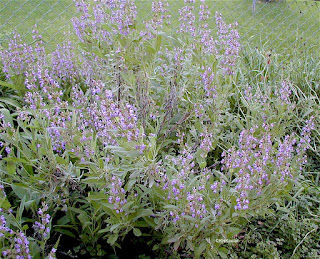 |
| water hyacinth (Eichronia crassipes) |
Sometimes I have a hard time coming up with an idea; sometimes I am trying to decide which post to upload first.
I have topics I want to write about but don't have the pictures: seeds and fruits, peanut plants, four o'clocks...in midwinter, it is hard to correct that.
It is great fun, this blog. It keeps me researching to get the information right. I have to keep up with stuff I would have let slide, in particular the changes in plant names. And I find myself buying books on topics I had not previously thought about, eastern North American wildflowers, ground covers, and Colonial-era gardeners, for example. Lately I've been studying Spanish because the stories of many North American plants extend into Latin America and I don't want to understand just part of the story before I retell it. Thus, this is a diverse and entertaining project!
 |
| Aztec ceremonies used marigold (Tagetes) |
Plant Confusions: Garden Sage and Sagebrush are Different: link
One is related to mints, the other to sunflowers
 |
| garden sage, Salvia officialis (mint family, Lamiaceae) |
Plant Story: Not Always Just Plain Vanilla: link
Botany Rules 1: Writing Plant Common Names and English Names: link
Visiting Northern California: Flowering Agaves! link
Agaves are cool!
 |
| agaves |
Unrelated Plants: The Strange Case of Nasturtium and Watercress link
Botany Rules 4: Who Makes the Rules? link
Is the coconut palm in the plant family Palmae or Arecaceae? (Both are correct!)
 |
| coconut palm (Cocos nucifera) |
Plant Story: Chocolate, Food of the Gods: link
Visiting China: Chinese Landscape Painting and Chinese Landscapes: link
and, well, 314 more of course.
I have no plans to stop writing. It is a big beautiful world with thousands of plants to appreciate!
My recommendation:
Go!
Observe!
Enjoy!
 |
| Snowy Range, southern Wyoming |
My recommendation:
Go!
 |
| central Australia, from the bus |
Observe!
 |
| swallowtail butterfly on mint, Pennsylvania |
 |
| Naoshima Island, Japan |
Comments and corrections welcome.
Kathy Keeler, A Wandering Botanist
More at awanderingbotanist.com
Join me on Facebook: https://www.facebook.com/AWanderingBotanist

No comments:
Post a Comment